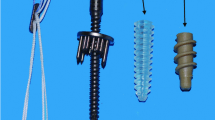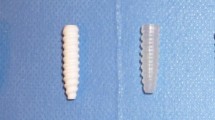Abstract
Purpose
Interference screw fixation of hamstring tendon grafts in bone has to overcome the challenges that tendons have a slippery surface and viscoelastically adapt under pressure. As the typical failure mode of the graft is to slip past the interference screw, it was hypothesized that the position and configuration of the graft end may be of influence on the fixation strength.
Methods
Different configurations of the graft ending and its effect to primary fixation with interference screws after viscoelastic adaptation were tested in six groups: I: graft and the screw inserted at the same depth, II/III: the graft overlaps the tip of the screw (interference screw of 28 and 19 mm in length, respectively), IV: strengthening of the graft ending with additional suture knots, V: Endopearl, respectively, and VI: effect of partial retraction of the screw after excessive insertion. In vitro tests were performed with fresh calf tendon grafts and interference screws in bone tunnels (fresh porcine distal femur) all of 8 mm in diameter.
Results
The relative position of the graft ending to the tip of the interference screw thereby was recognized as a significant factor on pullout forces. Further strengthening at the graft endings with additional suture knots or an Endopearl device could improve primary hold as well.
Conclusions
Better fixation strength is achieved if the tip of interference screw does not extend past the end of a tendon graft. Enforcement of the tendon end with sutures or an implant can further improve fixation.



Similar content being viewed by others
References
Adam F, Pape D, Schiel K, Steimer O, Kohn D, Rupp S (2004) Biomechanical properties of patellar and hamstring graft tibial fixation techniques in anterior cruciate ligament reconstruction: experimental study with roentgen stereometric analysis. Am J Sports Med 32(1):71–78
Ahmad CS, Gardner TR, Groh M, Arnouk J, Levine WN (2004) Mechanical properties of soft tissue femoral fixation devices for anterior cruciate ligament reconstruction. Am J Sports Med 32(3):635–640
Becker R, Voigt D, Starke C, Heymann M, Wilson GA, Nebelung W (2001) Biomechanical properties of quadruple tendon and patellar tendon femoral fixation techniques. Knee Surg Sports Traumatol Arthrosc 9(6):337–342
Benfield D, Otto DD, Bagnall KM, Raso VJ, Moussa W, Amirfazli A (2005) Stiffness characteristics of hamstring tendon graft fixation methods at the femoral site. Int Orthop 29(1):35–38
Black KP, Saunders MM, Stube KC, Moulton MJ, Jacobs CR (2000) Effects of interference fit screw length on tibial tunnel fixation for anterior cruciate ligament reconstruction. Am J Sports Med 28(6):846–849
Brand JC Jr, Nyland J, Caborn DN, Johnson DL (2005) Soft-tissue interference fixation: bioabsorbable screw versus metal screw. Arthroscopy 21(8):911–916
Brown CH Jr, Hecker AT, Hipp JA, Myers ER, Hayes WC (1993) The biomechanics of interference screw fixation of patellar tendon anterior cruciate ligament grafts. Am J Sports Med 21(6):880–886
Chang HC, Nyland J, Nawab A, Burden R, Caborn DN (2005) Biomechanical comparison of the bioabsorbable retroscrew system, bioscrew xtralok with stress equalization tensioner, and 35-mm delta screws for tibialis anterior graft-tibial tunnel fixation in porcine tibiae. Am J Sports Med 33(7):1057–1064
Coleridge SD, Amis AA (2004) A comparison of five tibial-fixation systems in hamstring-graft anterior cruciate ligament reconstruction. Knee Surg Sports Traumatol Arthrosc 12(5):391–397
Dargel J, Koebke J, Bruggemann GP, Pennig D, Schmidt-Wiethoff R (2009) Tension degradation of anterior cruciate ligament grafts with dynamic flexion-extension loading: a biomechanical model in porcine knees. Arthroscopy 25(10):1115–1125
Debandi A, Maeyama A, Lu S, Hume C, Asai S, Goto B, Hoshino Y, Smolinski P, Fu FH (2011) Biomechanical comparison of three anatomic ACL reconstructions in a porcine model. Knee Surg Sports Traumatol Arthrosc 19(5):728–735
Donahue TL, Gregersen E, Hull ML, Howell SM (2001) Comparison of viscoelastic, structural, and material properties of double-looped anterior cruciate ligament grafts made from bovine digital extensor and human hamstring tendons. J Biomech Eng 123(2):162–169
Duffee AR, Brunelli JA, Nyland J, Burden R, Nawab A, Caborn D (2007) Bioabsorbable screw divergence angle, not tunnel preparation method influences soft tissue tendon graft–bone tunnel fixation in healthy bone. Knee Surg Sports Traumatol Arthrosc 15(1):17–25
Halewood C, Hirschmann MT, Newman S, Hleihil J, Chaimski G, Amis AA (2011) The fixation strength of a novel ACL soft-tissue graft fixation device compared with conventional interference screws: a biomechanical study in vitro. Knee Surg Sports Traumatol Arthrosc 19(4):559–567
Jarvinen TL, Nurmi JT, Sievanen H (2004) Bone density and insertion torque as predictors of anterior cruciate ligament graft fixation strength. Am J Sports Med 32(6):1421–1429
Kleweno CP, Jacir AM, Gardner TR, Ahmad CS, Levine WN (2009) Biomechanical evaluation of anterior cruciate ligament femoral fixation techniques. Am J Sports Med 37(2):339–345
Meuffels DE, Docter PT, van Dongen RA, Kleinrensink GJ, Verhaar JA, Reijman M (2010) Stiffer fixation of the tibial double-tunnel anterior cruciate ligament complex versus the single tunnel: a biomechanical study. Arthroscopy 26(9):35–40
Meyer DC, Stalder M, Koch PP, Snedeker JG, Farshad M (2011) Contact pressure on ACL hamstring grafts in the bone tunnel with interference screw fixation—dynamic adaptation under load. Knee. doi:10.1016/j.knee.2011.11.005
Pomeroy G, Baltz M, Pierz K, Nowak M, Post W, Fulkerson JP (1998) The effects of bone plug length and screw diameter on the holding strength of bone-tendon-bone grafts. Arthroscopy 14(2):148–152
Roy S, Fernhout M, Stanley R, McGee M, Carbone T, Field JR, Dobson P (2010) Tibial interference screw fixation in anterior cruciate ligament reconstruction with and without autograft bone augmentation. Arthroscopy 26(7):949–956
Shelbourne KD, Nitz P (1990) Accelerated rehabilitation after anterior cruciate ligament reconstruction. Am J Sports Med 18(3):292–299
Shen PH, Lien SB, Shen HC, Wang CC, Huang GS, Chao KH, Lee CH, Lin LC (2009) Comparison of different sizes of bioabsorbable interference screws for anterior cruciate ligament reconstruction using bioabsorbable bead augmentation in a porcine model. Arthroscopy 25(10):1101–1107
Stadelmaier DM, Lowe WR, Ilahi OA, Noble PC, Kohl HW 3rd (1999) Cyclic pull-out strength of hamstring tendon graft fixation with soft tissue interference screws. Influence of screw length. Am J Sports Med 27(6):778–783
Vergis A, Gillquist J (1995) Graft failure in intra-articular anterior cruciate ligament reconstructions: a review of the literature. Arthroscopy 11(3):312–321
Walsh MP, Wijdicks CA, Parker JB, Hapa O, LaPrade RF (2009) A comparison between a retrograde interference screw, suture button, and combined fixation on the tibial side in an all-inside anterior cruciate ligament reconstruction: a biomechanical study in a porcine model. Am J Sports Med 37(1):160–167
Weiler A, Hoffmann RF, Siepe CJ, Kolbeck SF, Sudkamp NP (2000) The influence of screw geometry on hamstring tendon interference fit fixation. Am J Sports Med 28(3):356–359
Weiler A, Richter M, Schmidmaier G, Kandziora F, Sudkamp NP (2001) The EndoPearl device increases fixation strength and eliminates construct slippage of hamstring tendon grafts with interference screw fixation. Arthroscopy 17(4):353–359
Weimann A, Rodieck M, Zantop T, Hassenpflug J, Petersen W (2005) Primary stability of hamstring graft fixation with biodegradable suspension versus interference screws. Arthroscopy 21(3):266–274
Author information
Authors and Affiliations
Corresponding author
Rights and permissions
About this article
Cite this article
Stalder, M., Farshad, M., Snedeker, J.G. et al. Interference screws should be shorter than the hamstring tendon graft in the bone tunnel for best fixation. Knee Surg Sports Traumatol Arthrosc 21, 584–588 (2013). https://doi.org/10.1007/s00167-012-1957-y
Received:
Accepted:
Published:
Issue Date:
DOI: https://doi.org/10.1007/s00167-012-1957-y




